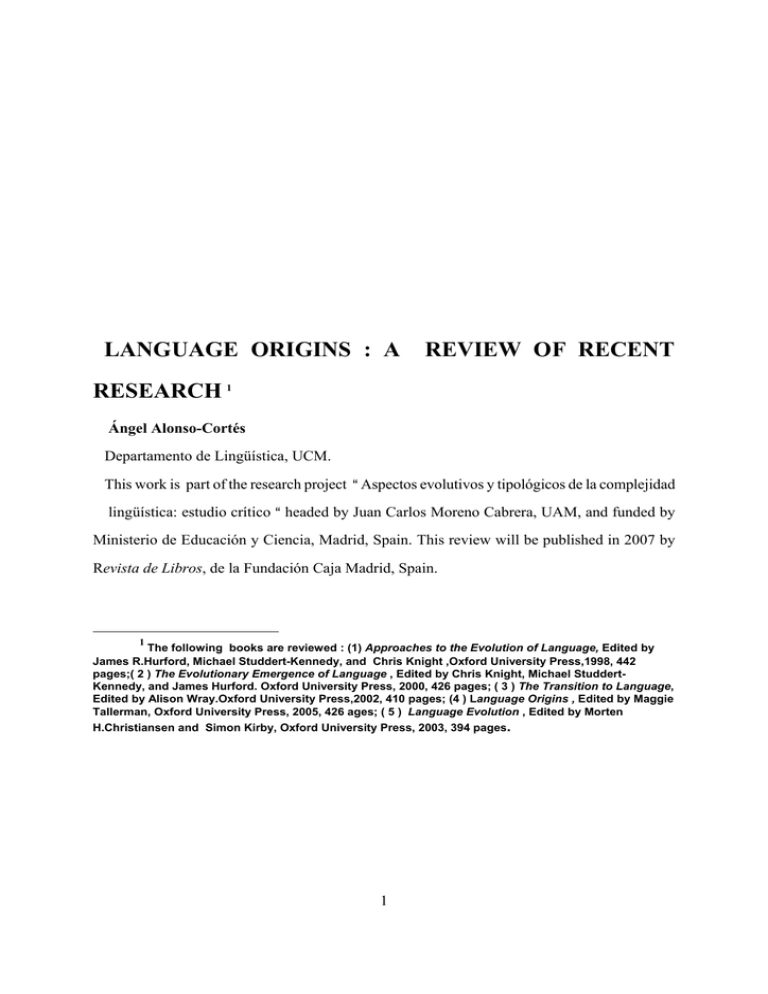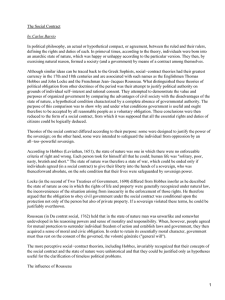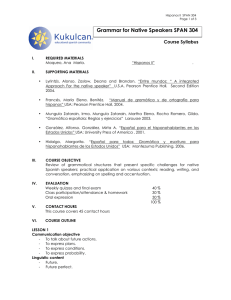language origins : a review of recent research 1 - E
Anuncio

LANGUAGE ORIGINS : A REVIEW OF RECENT RESEARCH 1 Ángel Alonso-Cortés Departamento de Lingüística, UCM. This work is part of the research project A Aspectos evolutivos y tipológicos de la complejidad lingüística: estudio crítico A headed by Juan Carlos Moreno Cabrera, UAM, and funded by Ministerio de Educación y Ciencia, Madrid, Spain. This review will be published in 2007 by Revista de Libros, de la Fundación Caja Madrid, Spain. 1 The following books are reviewed : (1) Approaches to the Evolution of Language, Edited by James R.Hurford, Michael Studdert-Kennedy, and Chris Knight ,Oxford University Press,1998, 442 pages;( 2 ) The Evolutionary Emergence of Language , Edited by Chris Knight, Michael StuddertKennedy, and James Hurford. Oxford University Press, 2000, 426 pages; ( 3 ) The Transition to Language, Edited by Alison Wray.Oxford University Press,2002, 410 pages; (4 ) Language Origins , Edited by Maggie Tallerman, Oxford University Press, 2005, 426 ages; ( 5 ) Language Evolution , Edited by Morten H.Christiansen and Simon Kirby, Oxford University Press, 2003, 394 pages. 1 1 The relevance of the topic After being a taboo topic for almost a hundred years, the topic of language origins has resurfaced . Not only linguists, but psychologists, biologists, and artificial intelligence experts as well have decided to beset that old fortress. The modern history of this topic can be traced to the Academy of Sciences in Berlin in 1789 in which the topic was formally addressed by students of language origins. A century on, 1866, the Societé Linguistique de Paris forbade writing on it. And a century after the prohibition , in 1976 the New York Academy of Sciences reopened the issue organizing a multidisciplinar conference. That year is considered the starting point for contemporary research on language origins. The motivation behind this revival was the cognitive revolution that framed language in a biological setting. This cognitive revolution embodied a computational model of grammar and a critical assesment of behavioural psychology. Additionally, new paleontological data had been added as well as a novel reconstruction of the vocal apparatus of the Neanderthal man. In spite of this, the New York conference did not yield surprinsing results, although left the old wine in new wineskins on the table. From 1996 the topic of language origins has acquired new dimensions, being the target of scientific meetings exclusively concerned with it. Te question is begged why this topic is the focus of attention by students of language origins of many different fields of scientific research.That is, we should address the question what interest this topic spurs in contemporary science. Such a topic demands a lot of time and money devoted to its development. Firstly, we must admit that it is not merely an intellectual curiosity but rather a core issue. In physics, the issue of the origins of the universe provides insight into how the universe looks at present. This 2 question is then related to that of how the universe was in its first three seconds. Present conditions of the universe result from its initial conditions. Thus this cosmological interest in physics does not derive from greek philosophy or physics. The present structure of the universe and the theories that face it are then logically related to the question of its origins. The case for language origins is no different than that of physics. The most concerned field in the language origins problem is darwinist biology, in which it has acquired high significance in recent years. Eighteenth century philosophers, took special interest in this particular topic because it had interest for their political and anthropological theory. Rousseau 2 become interested in language origins because of his interest in the nature of human beings, their moral and psychological faculties that guide human behaviour in society. For Rousseau and his followers , language takes up an outstanding position in enlightening human nature. Language is considered a social institution with natural roots. It is an invention made possible to humanity by natural means, as the voice, and it is a convention, something not natural, contrary to animal A languages A, like bee dance. In a natural state, humanity does not need a conventional language, Rousseau says. Only when humans find themselves in a social community or state, should they demand a conventional language. One stunning conclusion at which Rousseau arrives is that languages are not different, but unequal 3 . It should be no wonder then that more than two centuries after Rousseau and the many changes undergone in the sciences, interest has reemerged anew, as these volumes witness. The topic of language origins is stimulating both as a pure scientific topic and as a means to obtain insights into the anthropological and psychologic side of human makeup. As a purely scientific topic, the inquiry into language origins may support or falsify language conceptions held by linguists . Language origins research is relevant to linguistics, a field divided into very different research programs and conceptions. Besides, language origins is relevant to biology because biological theory strives to account for humans mental faculties . 2 Jean-Jacques Rousseau, Discours sur l=origine et les fondements de l=inegalité parmi les hommes. en J.J. Rousseau, Oeuvres complètes, vol. 2, Paris, Seuil,1971, págs.220 y ss 3 Jean-Jacques Rousseau, Essai sur l=origine des langues., cap. Texte integrale reproduit d=apres l=edition de A. Belin de 1817. Copedith, Paris, 1970. I. 3 Biology as well is not an homogeneous field. Today >s Darwinism overwhenmingly besieges back the intellectual capacities of humans. Darwinism supporters argue strongly for a natural selection and a non saltationist account of language, while nondarwinists argue the contrary. The ultimate difference with previous approaches to language origins lies in the methods currently employed. Since 1996, students of language origins have added new research methods to their tool box. Such methods are computational models, game theory, evolutionary game theory, and a cognitive view of psychology and linguistics. Every volume which we deal with is a contribution made to the conferences on origins and evolution of language organized from 1996 to 2002, and their baseline is a combination of those methods. Results are not in complete agreement, as it turns out from previous approaches to the topic, but most lead to a new vision which deviate from the Just So Stories which were pervasive in the field of origins. Nevetherless disagreements exist, the most serious of which questions the very definition of language.Some contributors conceive of language as a method of communication specific to humans, while others assert that language is a medium for the representation of thought. Some contributions identify language origins with the modality ( speech, or manual ) in which language is made perceptible. Eighteenth century philosophers made the same identification. Thus Condillac claimed that language came first in the manual mode, and later was transferred into the vocal mode, and Rousseau held that language came first as song, an idea later fostered by Darwin and Otto Jespersen 4 . The origin of language modality, appealing as it may be, surely is the less enticing. The reason is that there is a conceptual and factual difference between language and speech, or spoken discourse. This question is not simply a moot point. However one understands language, be it communication , or representation of thought, and whatever the properties you want assign to language, speech and language must be distinguished.Now most contributors are interested in language, not merely in its medium, be it hand or speech. If some property of language is settled, it is that language is made up of symbols, and a symbol is a bidirectional mapping between a mental representation of sound / hand movement and concept. 4 C.Darwin, The Descent of Man, and Selection in Relation to Sex, John Murray, London, 1871 ; Otto Jespersen , Language, George Allen and Unwin, London, 19224 The nature of the mapping involves tacit conventions made by speakers. Tacit conventions are not proven to exist in animal communication as they demand a theory of mind. Besides, linguistic symbols accrue in human groups. This accretion of symbols constitutes a particular language ruled by a grammar. Language origins scientists make a distinction between language and languages, and therefore, the topic splits into language origins and languages evolution. These volumes combine both topics, although it would be desirable to keep them apart. The essential question that students of language origins deal with is not that of the origin of the medium of language, but language conceived as a method of communication. This question neatly divides scholars into two groups. On the one side, there are drawinists evolutionists for whom language is a consequence of selection, be it natural selection , or sexual selection.At the other side, there are supporters of an emergency, or a catastrophe theory of language origins, for whom language originates not in natural selection, but rather as a sudden result of brain complexity, or perhaps by means of some mutation. 2 Evolutionists theories of language origins. Current evolutionists theories assert two points. First, language is for communication. Second, language is a complex organ, as the eye, thus its form and origin derive from natural selection. As concerns the first point, it is striking that modern evolutionsts theories run against Darwin, for whom language, whose essential property lay in being articulated 5 , was the medium that carries thinking 6 . But Darwin did not consider language something uniquely human, for dogs as well , he asserted, were able to think. Doubtless, Darwin , like Sperber and Wilson 7 , must have had in 5 Aristoteles ( Historia Animalium ) asserted as well that language is articulated, contrary to animal signals. 6 C.Darwin, The Descent of Man, p.57. 7 Sperber and Wilson, La Pertinence,Minuit, Paris, 1989 assert that animals make use of some sort of language as defined by them: a tool for processing and memorization of information. 5 mind the story of Chrysippus=s dog, which Sextus Empiricus tells in his Pyrrhonian Outlines, that when chasing its prey, and having lost its track in a crossroad, sniffed the first two paths, and not detecting the prey=s scent, hastily rushed to chase it taking the thirdth path. Crysippus inferred that the dog reasoned without articulate and conventional language. Actually, Sextus=s anecdote is intended to show that there is some kind of nonpropositional thinking. Language can accompany thinking, but thinking does not demand language. Concerning the second point, that language is a complex organ, as the eye, is an unwarranted assertion. First, it is unknown how one of the most important feature of language, the fact that every language has a grammar, works. Secondly, complexity can be measured in precise mathematical terms, as in Kolmogorov=s complexity theory, for example. However, supporters of language as a complex organ have not provided such a measure. On the other hand , nonsupporters of natural selection for language, like Chomsky=s minimalist theory, hold that grammar is a bare mechanism. Language complexity is then a very significant aspect in the study of language origins. Conventional wisdom in twentieth century linguistics assumes that every language is equally complex. This wisdom is an aspect of the Uniformitarian Principle in science established by British nineteenth century scientists . The principle asserts that causes or forces that acted in the formation of earth surface in its inception still act because the earth remains in a kind of steady state. Expressed in these well known words: present is the key for past. The principle served as a beacon to guide scientific research in the natural sciences, geology and biology. Later it was taken up by Darwin himself. Uniformitarianism has its source in british geologists James Hutton and Charles Lyell. It was introduced by William Whewell 8 in the philosophy of science in 1832.A consequence of this principle is gradualism: changes in the earth surface are not abrupt, or catastrophic, but gradual . Darwin tells in his Autobiography that he took with him the first volume of Lyell=s Principles of Geology in the Beagle. Lyell=s work made such an impact on Darwin that Darwin took up gradualism in organic transformations. This lead Darwin to the idea of slow and continuous transformation of organisms so that new species originate as a result of 8 Review of Charles Lyell, Principles of Geology, vol 2, Quaterly Review, 47, pp103-132. (1832) 6 gradual transformations. Nineteenth century linguistics as well took up this principle put forth by the very Lyell, who introduced it in his 1863 book The Geological Evidence of the Antiquity of Man to explain how languages evolved gradually out of dialects. Thus Lyell headed off German neogrammarians in establishing that languages change gradually. In fact, in chapter XXIII of this book he claims that linguistic changes are gradual. Adoption of Uniformitarianism in linguistics lead to significant sequels. One of them lies in that the language origins problem would disappear because uniformitarianism establishes that language has always been the same, while changes undergone in languages are gradual yielding to new languages in this way. Another consequence fixes the complexity of languages on the same level . That means that every language, past, present and future are equally complex because the same rules and constraints that acted in the languages origin still are present and will continue to do so in the future . This second consequence is a natural extension of the uniformitarian principle as applied to geology : whereas natural forces act in the earth with the same degree of intensity, languages find themselves at the same degree of complexity because rules and constraints act upon languages with the same intensity. A last consequence of uniformitarianism would be that just as the earth remains in a steady state, language is fixed in a steady state. Thus languages would change in an eternal cycle, with no predetermined direction. Realizing that intellectual capacities must be accounted for within his selection theory plus uniformitarianism , Darwin devoted two volumes to weaving arguments on how such capacities must be inserted in either the theory of natural selection or sexual selection or both. Current evolutionist theories that follow Darwin=s uniformitarianism face problems that Darwin dodged and left unresolved. In order to see what this problems are, let us sketch the mechanism of evolutionary theory. The theory understands life and behaviour as a blind machine that works with the following components : ( 1 ) variation of organisms / genes / features of behaviour +( 2 ) function of organisms / ... + ( 3 ) competition of organisms/ .... + ( 4 ) selection ( natural, sexual, kin ) of the fittest + ( 5 ) hereditary transmission. The steepest problems for this machine arise in ascertaining ( i ) what selection pressures have acted on language origins; ( ii ) which is the original function or functions of language ; ( iii ) 7 how the putative language learning mechanism (as well known as Universal Grammar, Language Acquisition Device ) has been incorporated in our genetic makeup ; ( iv) how language bears on fitness ( reproductive efficiency ) , as the theory predicts ; and ( v ) which is the ecological scenario where language could arise. Some students of language origins in these volumes deal with such topics, although their answers are either mutually inconsistent or entirely speculative. I will start here with three questions that students of language origins strive to answer. First , concerns the original function of language. Second, bears on fitness, and thirdth what kind of selection acts on language. The question of language function is most significant for linguists : did language have the communicative function in its origin that it has at present ? Computational models that simulate how language arises in a community of linguistic agents assume as initial conditions in the model that language is designed for communication. But these models just ignore that linguistic communication seems a consequence of the existence in humans of empathy or a theory of mind, which nonhuman primates lack. The ability to understand utterances requires capturing the intention of the speaker . Such a way of understanding utterances is made possible to the extent that the hearer is able to put herself into other=s mind.The utterance isn=t it hot in here ? is an invitation for the hearer to open the window. The hearer interprets that utterance as if he had uttered it himself, as a kind of mental guessing. Some contributors to these volumes claim that primates lack empathy. Evolutionary theory skips over it, up to now. It might be that he function of language was not for communication of infromation, as Robin Dunbar holds in a suggestive theory of language origins. For Dunbar, language would fulfill a contact or phatic function ( in Malinowski=s sense ) . He names such contact A grooming A. Such a function establishes an atmosphere of sociability within a group. The rationale for this function lies in that without language such social contacts can be mantained if the group is small. When the group increases in number there would not be enough time to groom as many people. However, language allows to keep the contact with many more members of the group. Actually, what language does is a discharge of opportunity costs : a quantity of time used for a certain activity A can be spared and thus used for other number n of activities. In Dunbar=s scenario language is used for grooming more people. 8 How can one go from the phatic function to the communication of information ? We do not know. Even accepting the step from one function to the other, the communication of information is not warranted. In the animal world conspecifics communicate with each other by signals to warn of danger, to ask for food, to advertise sexual drives, to mark territory, and similar states of the organism. Conspecifics communicate to obtain mutual benefits, that means, because they cooperate. This idea is an extension of game theory to animal communication. Cooperation is a decision strategy in the A prisoner=s dilemma A. In this game 9 , two persons are apprehended by the police, who keeps them separated. The police offers them this deal : ( 1 ) If one confesses and the other does not, the former will be given a reward... and the latter will be fined.. ; ( 2 ) If both confess, each will be fined. At the same time, each has good reason to believe that ( 3 ) if neither confesses both will go clear. The first time this game ( i. e., a set of decision strategies ) is played , one should choose (1), that is, one defects because one thinks that one has higher probabilities of winning the game. The more the game is played , the probability that the two protagonists will choose ( 2 ) increases . But if the game is played an indefinite number of times, both will end up choosing ( 3 ), that is, both will cooperate. 9 W. Poundstone, Prisoner=s Dilemma, Anchor Books, New York,1993. 9 The prisoner=s game sets up a conflict between players, and the best result for the players is obtained by cooperating . That best result is an equilibrium point. Some students of language origins clinge to a cooperative strategy and they just insist on claiming that language is grounded on cooperation , or the prisoners=s game played along our evolutionary history. In fact, Grice=s philosophy of language, that has had a pervasive influence on current linguistics, wields cooperative behaviour as the driver of linguistic communication. But things are not be as they seem . Cooperation is an strategy in case of conflict. Linguistic communication does not result from any conflict . In standard communicative acts , when some information is conveyed, such information is costless. There is not tangible benefit. Imagine a Japanese tourist in downtown Madrid that asks me where the Prado Museum is located, and he asks me in English, a language that both of us know. I reply indicating where the Prado is, spending no more than one minute. What benefit do I obtain ? . Linguistic communication is not a stock exchange game in which information may be essential and has a cost as well as a benefit. Cooperation can hardly lead to language, at least to a modern language. Language has two features that move it further away from cooperation : language is cheap, or costless , and language can be use to prevaricate . These properties mark off the limits of language and animal signals, which are costly and true , or at most only deceptive. Because language is costless , it allows lying. Prevarication has no parallel in animal signals. My dog barks because it has sniffed some alien and not because it wants to make me believe that there is an alien at the door but in fact there is not. Language is a group phenomenon. It arises in a group so that members of the group become coordinated due to the fact that they share a set of common symbols . Coordination allows agents to carry out different and specialized tasks. In short, a group that has developped the division of work may develop a language that is shared by their members so that the group is coordinated. The division of work as developped by humans is unique to our species. It could explain why humans develop language, but dogs, or elephants do not 10 . As a language may be shared by millions of selfish 10 Adam Smith pointed out in his Wealth of the Nations that language and the division of work were related in some way. I have argued on this relationship in A From Signals to Symbols: Grounding Language Origins in Communication Games A, in : AhtiVeikko Pietarinen, ed., Game Theory and Linguistic Meaning ( Current research in the 10 speakers with no genetic relatedness , neodarwinists theories of evolution do not allow for a feature like a coordinating language that goes beyond competition and selfishness. Language, understood as a coordinating activity in a group, remains out of the natural selection framework. Besides the phatic and synergic ( or cooperative ) functions , students of language origins have proposed a thirdth function that might have produced language. It can be called the rhetorical function of language. It was Darwin who first observed that some nonhuman primates and male singers birds competing with other conspecifics males produced musical cadences in order to advertise themselves to a conspecific female that they are best fitted for reproduction . Females then select males that show the best displays ( i.e. rhetoric ) . Darwin called such choosing by females sexual selection. He inferred that in humans or their forebears the voice might have the same purpose as in nonhuman primates and singing birds as an advertisement of fitness. Humans might use their unique capacity for vocal imitation to reproduce musical calls with articulate sounds to express emotions, thereby emotive and seductive words would be coined. Afterwards, Darwins says, thinking would make use of a vocal language as its essential support . Evidence for this is provided by Darwin=s observation that humans have enhaced lips and tongue more so than other higher mammals. This proposal has not gone unnoticed by some current students of language origins. Such a proposal is appealling because it fits well with generative linguists=s assertion that language is some kind of arbitrary ornament and not a true adaptation to environmental pressures. Sexual selection resorts to A marketing advertisements A more o less unmotivated as antlers, colors in some animals , and beard and voice in male humans. Semantics / Pragmatics Interface 17 ), Elsevier, Oxford, 2006, páges. 21-33. 11 Whether phatic, synergic and rhetorical functions are adequate explanations for the origin of language is a difficult task to evaluate because we lack evidence that allow us to test the theories. I have argued against a synergic function for language origins, language being a coordinating activity. Phatic and rhetorical functions appear more sensible and compatible with language as coordination.Even so, these three functions for language origins face two problems: ( i ) the handicap problem11 , and ( ii ) the fitness problem. The first one araises from the fact that animal signals pose certain dangers for survival. Colors and songs in birds attract attention of predators, putting animal=s life at risk . Which is the handicap associated with language ? A robust candidate could be prevarication, the property of language that allows speakers to lie. This poses a serious problem for evolution : how is it that a system of arbitrary and conventional signals that allows to lie is evolutionarily stable ? As evolutionary biologists ususlly give answers to many things, it can be argued that presence of a handicap heralds that organism is fit because it survives and can reproduce in spite of the handicap 12 . Therefore, language would be evolutionarily stable because it allows lying ! Paradoxical though it may be, it can be assumed . If language allows us to make out statements that are not true, then one can invent stories, myths, numbers and theories. Lying is a case of reference displacement , the feature of language that makes it possible to refer to objects and situations that are absent 13 . Otherwise said, lying is equal to the absence of stimulous argument wielded by Chomsky. But lying can=t be a evolutionary stable strategy . If it were, for every lying S-strategy, it would be possible to find another lying S=-strategy. Therefore, this signaling system would not be evolutionary stable in J.Maynard Smith=s sense 14 . In short, sexual selection must explain how language is costless, 11 For the handicap principle, see Amotz Zahavi, Avishag Zahavi, Na=ama Ely y Melvin Ely, The Handicap Principle,Oxford University Press, 1999; and R.Dawkins, The Selfish Gene, Oxford University Press, 1989. 12 R. Dawkins, The Selfish Gene, p. 160. 13 Karl Popper highlighted that lying has been the real origin of language. See P.A. Schilpp, The Philosophy of Karl Popper, vol. 2, pp.1112-1113. 14 J. Maynard Smith, Evolution and the Theory of Games,Cambridge University Press, 1982. 12 while animal signals are not. Linguistic communication thus has some properties not expected in animal signals: prevarication and uncostliness. As for the second problem sexual selection theory must face, the fitness of language, it fares just a little bit better. Most ecological scenarios designed by students of language origins take up fitness as an assumption of the models, not a prediction. Some models equal fitness and communicative success. Although such equivalence may be reasonable, there is no empirical evidence for such an assumption. The relationship between fitness and language is indirect at most. Let us imagine that there are two couples. One of them speaks the same language, but the other doesn=t . The first couple is likely to breed more frequently , but not the second one. But language barriers are not so unbridgeable that communicative success can=t be achieved when a couple meet. Just that it is unlikely. It is no wonder that computational models made by Solan, Ruppin, Horn y Edelman show that those who speak the same language breed more frequently. This research just assumes that fitness contributes to languge diversity, while in a model that does not bind fitness and language the evolutionary rate of languages decreases dramatically, and a less significant number of languages is formed. Other more sophisticated computational models, like Nowak=s model, as well assume fitness as a condition, not as a result of the model. The language and fitness relationship appears indirectly in the well-known correlation of languages and genes studied by Cavalli-Sforza and Feldman. But contrary to bird colors and the spectacular peacock tail, that are genetically transmitted, languages are transmitted culturally. That makes a difference that has been taken up by some computational simulations of language transmission to explain some properties that make language learnable. 3 Evolution by creeps and evolution by jerks Some alternatives have been offered to get out of this evolutionary mire.All are under the catastrophism umbrella. Catastrophist theories assume that abrupt changes are involved in geological and biological changes Evolutionists and catastrophists fighting each against the other already arose in the nineteenth century opposing Darwin and Lyell to Cuvier and Agassiz.This standoff finished with a definite edge over catastrophism supporters. Doubtless, 13 nieneteenth century Zeitgeist favored evolutionism. 20th century as well has witnessed commotions in both headquarters. Uniformitarianists ( the astronomer Fred Hoyle and his associates ) and catastrophists ( supporters of big - bang cosmology ). Today, the Zeitgeist favors catastrophists. Evidence for abrupt changes in biology and geology are clear and sharp. Catastrophists theories are supported by inadequacies and constraints on darwinists theories as well as by empirical evidence, like dinosaurs extinction by a meteorit hit . Mathematics has entered the stage with Thom=s catastrophe theory. Catastrophists as well have supporters in the linguistic headquarters. Chomsky is the most well known catastrophist supporter 15 . He doubted from very early that darwinism could explain language origins. He put forth that language is a case of evolutionary emergency, a qualitatively distinct phenomenon caused by brain complexity. Currently, Chomsky still maintains this earlier opinion.It must be admitted that his opinion has not remain out of fashion because there could not have been proved homologies between humans and nonhuman primates, especially the big apes. Dereck Bickerton is the linguist that has wielded the catastrophist torch most strongly. An scholar of pidgin and creole languages, Bickerton has proposed that language arose from protolanguage in one shot. He claims that protolanguage is like a modern language, but without syntax. Its function would be synergetic, or cooperative, grounded on reciprocal altruism. The catastrophe involved would be a genetic mutation that might have comprised a generative syntax of infinite power. His proposal is difficult to support . For one thing, words only have a function in a modern language: they project phrases and contain syntactic, phonological and semantic information. It has no sense to assert that words can work in a language without syntax. Besides protolanguage, some computational simulations presented in these volumes definetely support nongradualist evolution of language systems. Both Oudeyer and Lindblom show that a true phonetic system is the result of selforganization, not of gradual evolution. Inherent properties to the system that organize it optimally account for three, five, etc vowel systems which are empirically attested. Selforganization is not unknown to biology. So it is not an unexpected result 15 N. Chomsky, Language and Mind, Harcourt, New York, 1968, p.70. 14 that in a phonetic system perception and production constraints plus a learning mechanism driven by imitation do the work by themselves without innate assumptions. Computational simulations show the transition from holistic or unanalyzable signs to componential signs, that is, signs that can be segmented and can combine with others to assemble complex words. The most significant result coming from these simulations clearly show that linguistic generalizations, which are the crux of grammar and grammar learning, are an outcome of data compression by the learner. Data compression is almost the best strategy for learning out of a subset of data in hypothesis formation. Such strategy is a result of computational learning theory that takes advantage of methods worked out by both Solomonoff and Kolmogorov . When a language learner faces the task of taking in linguistic data , a A learning bottleneck A appears because the learner is not exposed to the set of all possible linguistic input. Computational learning theory solves that bottleneck compressing data. It works out the argument that the least complex hypothesis ( in Kolmogorov=s sense ) out of a set of finite hypotheses is the most likely. When applied to language learning, this method allow us to get rid of Universal Grammar, and as a cosequence, the poverty of stimulous argument wielded by Chomsky breaks up. Once a grammatical, or phonetic system emerges it is transmitted culturally from one generation to another . The system does not need an innate Universal Grammar for its learning: imitation, data compression , and other general learning mechanisms accounts for it. Thus language becomes a kind of tangible entity, not a mental one built up by innate features, although it turns out to be mentally represented. Language is learnable due to glossogenetic pressures ( Hurdford=s expression ) those that make language easy to learn. Recursivity and Componentiality are as well the best simple hypotheses that make language learnable in a short time.Besides, language becomes the target of cultural not genetic selection .Cultural selection makes language a set of memes in populations of agents that meet and learn language from each other. So computational simulations start from a population P of agents, a general learning mechanism M , and an array of iterated learning games G . Agents do not compete ( do not play the prisoner=s game ), and are not driven by fitness . Therefore natural selection is left out. Linguistic agents eventually become coordinated offhand without a central authority. In short, language emerges as a free market does 15 : a population of agents trading goods and services moved by a an invisible hand that coordinate agents preferences . Summing up. Current language origins enterprise is yielding new vistas not only on the vexed problem of how language originated. Some general problems of linguistics may be enlightened by this research. It has expanded our understanding on how language has really emerged giving up just so stories. It has spurred biologists, computer scientists, engineers, psychologists, arqueologists, mathematicians, and linguists to get involved in a common enterprise. That would be a tour de force by itself. However many questions remain unanswered, if they can be answered at all, it is to be expected that the main questions of language origins will be fixed in a non distant future. 16





